What is Asset Allocation?
Asset allocation is the strategy of dividing your investment portfolio across various asset classes like stocks, bonds and money market securities. Essentially, asset allocation is an organized and effective method of diversification.
Your options typically fall within three classes - stocks, bonds and cash. Within these three classes are subclasses (the variations within each category). Some subclasses and alternatives include:
Large-cap stock - These are shares issued by large companies with a market capitalization generally greater than $10 billion. Mid-cap stock - These are issued by mid-sized companies with a market cap generally between $2 billion and $10 billion. Small-cap stocks - These represent smaller-sized companies with a market cap of less than $2 billion. These types of equities tend to have the highest risk due to lower liquidity. International securities - These types of assets are issued by foreign companies and listed on a foreign exchange. International securities allow an investor to diversify outside of his or her country, but they also have exposure to country risk - the risk that a country will not be able to honor its financial commitments. Emerging markets - This category represents securities from the financial markets of a developing country. Although investments in emerging markets offer a higher potential return, there is also higher risk, often due to political instability, country risk and lower liquidity. Fixed-income securities - The fixed-income asset class comprises debt securities that pay the holder a set amount of interest, periodically or at maturity, as well as the return of principal when the security matures. These securities tend to have lower volatility than equities, and have lower risk because of the steady income they provide. Note that though payment of income is promised by the issuer, there is a risk of default. Fixed-income securities include corporate and government bonds. Money market - Money market securities are debt securities that are extremely liquid investments with maturities of less than one year. Treasury bills (T-bills) make up the majority of these types of securities. Real-estate investment trusts (REITs) - Real estate investment trusts (REITs) trade similarly to equities, except the underlying asset is a share of a pool of mortgages or properties, rather than ownership of a company. Maximizing Return & Minimizing Risk
The main goal of allocating your assets is to minimize risk given a certain expected level of return. Of course to maximize return and minimize risk, you need to know the risk-return characteristics of the various asset classes. Figure 1 compares the risk and potential return of some popular choices:
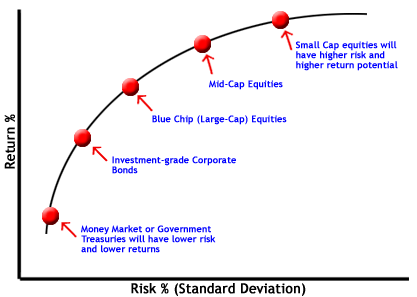 |
| Figure 1 |
Equities have the highest potential return, but also the highest risk. On the other hand, Treasury bills have the lowest risk since they are backed by the government, but they also provide the lowest potential return. This is the risk-return tradeoff. Keep in mind that high risk choices are better suited for investors who have a high risk tolerance (can stomach wide fluctuations in value), and who have a longer time horizon to recover from losses.
It's because of the risk-return tradeoff - which says that potential return rises with an increase in risk - that diversification through asset allocation is important. Since different assets have different risks and market fluctuations, proper asset allocation insulates your entire portfolio from the ups and downs of one single class of securities. So, while part of your portfolio may contain more volatile securities - which you've chosen for their potential of higher returns - the other part of your portfolio devoted to other assets remains stable. Because of the protection it offers, asset allocation is the key to maximizing returns while minimizing risk.
Deciding What's Right for You
As each asset class has varying levels of return and risk, investors should consider their risk tolerance, investment objectives, time horizon and available capital as the basis for their asset composition. Investors with a long time horizon and larger sums to invest may feel more comfortable with high risk, high return options. Contrastingly, investors with smaller sums and shorter time spans may feel more comfortable with low risk, low return allocations.
To make the asset allocation process easier for clients, many investment companies create a series of model portfolios, each comprising different proportions of asset classes. These portfolios of different proportions satisfy a particular level of investor risk tolerance. In general, these model portfolios range from conservative to very aggressive:
 |
Conservative model portfolios generally allocate a large percent of the total portfolio to lower-risk securities such as fixed-income and money market securities. The main goal of a conservative portfolio is to protect the principal value of your portfolio (the money you originally invested). As such, these models are often referred to as "capital preservation portfolios".
Even if you are very conservative and prefer to avoid the stock market entirely, some exposure can help offset inflation. You could invest the equity portion in high-quality blue chip companies, or an index fund, since the goal is not to beat the market.
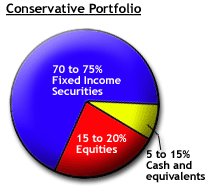 |
Moderately Conservative Portfolios
A moderately conservative portfolio is ideal for those who wish to preserve a large portion of the portfolio's total value, but are willing to take on a higher amount of risk to get some inflation protection. A common strategy within this risk level is called "current income." With this strategy, you chose securities that pay a high level of dividends or coupon payments.
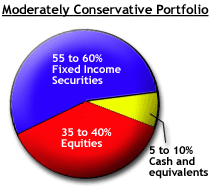 |
Moderately Aggressive Portfolios
Moderately aggressive model portfolios are often referred to as "balanced portfolios" since the asset composition is divided almost equally between fixed-income securities and equities in order to provide a balance of growth and income. Since moderately aggressive portfolios have a higher level of risk than conservative portfolios, this strategy is best for investors with a longer time horizon (generally more than five years), and a medium level of risk tolerance.
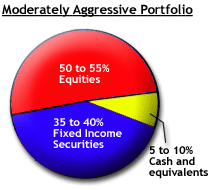 |
Aggressive portfolios mainly consist of equities, so their value tends to fluctuate widely. If you have an aggressive portfolio, your main goal is to obtain long-term growth of capital. As such, the strategy of an aggressive portfolio is often called a "capital growth" strategy. To provide some diversification, investors with aggressive portfolios usually add some fixed-income securities.
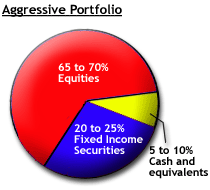 |
Very Aggressive Portfolios
Very aggressive portfolios consist almost entirely of equities. As such, with a very aggressive portfolio, your main goal is aggressive capital growth over a long time horizon. Since these portfolios carry a considerable amount of risk, the value of the portfolio will vary widely in the short term.
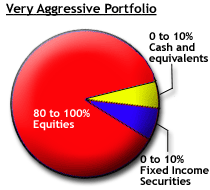 |
Tailor Your Allocations to Your Needs
Note that the above outline of model portfolios and the associated strategies offer only a loose guideline - you can modify the proportions to suit your own individual investment needs. How you fine tune the models above can depend on your future needs for capital and what kind of investor you are. For instance, if you like to research your own companies and devote time to stock picking, you will likely further divide the equities portion of your portfolio among subclasses of stocks. By doing so, you can achieve a specialized risk-return potential even further within one portion of your portfolio.
Also, the amount of cash and equivalents or money market instruments you place in your portfolio will depend on the amount of liquidity and safety you need. If you need investments that can be liquidated quickly or you would like to maintain the current value of your portfolio, you might consider putting a larger portion of your investment portfolio in money market or short-term fixed-income securities. Those investors who do not have liquidity concerns and have a higher risk tolerance will have a small portion of their portfolio within these instruments.
Asset Allocation Strategies
While you decide how to allocate your portfolio, keep in mind several allocation strategies and their goals. Each one offers a different approach based on the investor's time frame, goals and risk tolerance. The most common strategies include strategic, tactical, constant weighting and systemic asset allocation.
The Importance of Maintaining Your Allocated Portfolio
Once you have chosen your portfolio investment strategy, it's important to conduct periodic portfolio reviews, as the value of various assets will change. This affects the weighting of each asset class, meaning over time, a portfolio can grow from containing primarily one type of asset class to another. For example, if you start with a moderately conservative portfolio, the value of the equity portion may increase significantly during the year, suddenly giving you an equity heavy portfolio. This makes the portfolio more like that of an investor practicing a balanced portfolio strategy, which is higher risk!
In order to reset your portfolio back to its original state, you need to rebalance your portfolio. Rebalancing is the process of selling portions of your portfolio that have increased significantly, and using those funds to purchase additional units of assets that have declined slightly or increased at a lesser rate. This process is also important if your investment strategy or tolerance for risk has changed.
The Bottom Line
Asset allocation is a fundamental investing principle because it helps investors maximize profits while minimizing risk. The different asset allocation strategies described above cover a wide range of investment styles, accommodating varying risk tolerance, time frames and goals. Once you've chosen an appropriate asset allocation strategy, remember to conduct periodic reviews of your portfolio to ensure you're maintaining your intended allocation and are still on track to your long-term investment goals.



